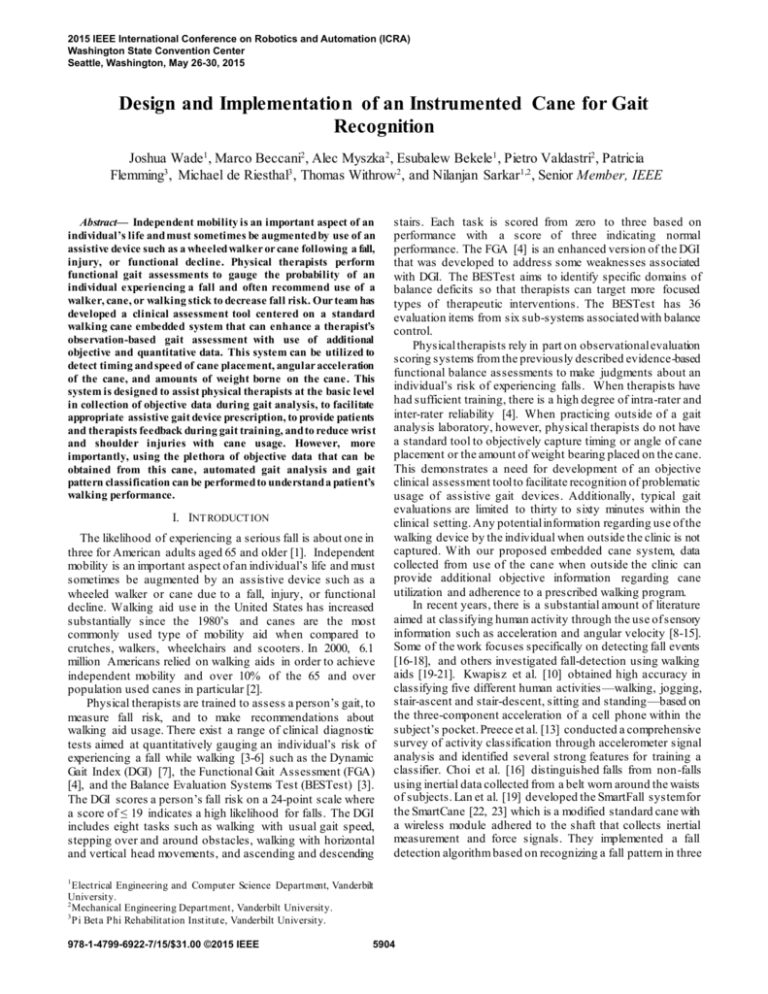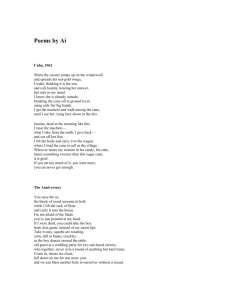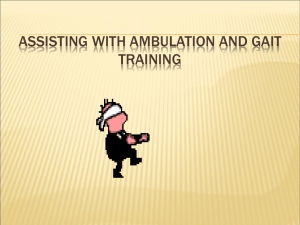Design and Implementation of an Instrumented Cane for Gait
advertisement

2015 IEEE International Conference on Robotics and Automation (ICRA) Washington State Convention Center Seattle, Washington, May 26-30, 2015 Design and Implementation of an Instrumented Cane for Gait Recognition Joshua Wade1 , Marco Beccani2 , Alec Myszka 2 , Esubalew Bekele 1 , Pietro Valdastri2 , Patricia Flemming3 , Michael de Riesthal3 , Thomas Withrow2 , and Nilanjan Sarkar1,2 , Senior Member, IEEE Abstract— Independent mobility is an important aspect of an individual’s life and must sometimes be augmented by use of an assistive device such as a wheeled walker or cane following a fall, injury, or functional decline. Physical therapists perform functional gait assessments to gauge the probability of an individual experiencing a fall and often recommend use of a walker, cane, or walking stick to decrease fall risk. Our team has developed a clinical assessment tool centered on a standard walking cane embedded system that can enhance a therapist’s observation-based gait assessment with use of additional objective and quantitative data. This system can be utilized to detect timing and speed of cane placement, angular acceleration of the cane, and amounts of weight borne on the cane . This system is designed to assist physical therapists at the basic level in collection of objective data during gait analysis, to facilitate appropriate assistive gait device prescription, to provide patients and therapists feedback during gait training, and to reduce wrist and shoulder injuries with cane usage. However, more importantly, using the plethora of objective data that can be obtained from this cane, automated gait analysis and gait pattern classification can be performed to understand a patient’s walking performance. I. INT RODUCT ION The likelihood of experiencing a serious fall is about one in three for American adults aged 65 and older [1]. Independent mobility is an important aspect of an individual’s life and must sometimes be augmented by an assistive device such as a wheeled walker or cane due to a fall, injury, or functional decline. Walking aid use in the United States has increased substantially since the 1980’s and canes are the most commonly used type of mobility aid when compared to crutches, walkers, wheelchairs and scooters. In 2000, 6.1 million Americans relied on walking aids in order to achieve independent mobility and over 10% of the 65 and over population used canes in particular [2]. Physical therapists are trained to assess a person’s gait, to measure fall risk, and to make recommendations about walking aid usage. There exist a range of clinical diagnostic tests aimed at quantitatively gauging an individual’s risk of experiencing a fall while walking [3-6] such as the Dynamic Gait Index (DGI) [7], the Functional Gait Assessment (FGA) [4], and the Balance Evaluation Systems Test (BESTest) [3]. The DGI scores a person’s fall risk on a 24-point scale where a score of ≤ 19 indicates a high likelihood for falls. The DGI includes eight tasks such as walking with usual gait speed, stepping over and around obstacles, walking with horizontal and vertical head movements, and ascending and descending stairs. Each task is scored from zero to three based on performance with a score of three indicating normal performance. The FGA [4] is an enhanced version of the DGI that was developed to address some weaknesses associated with DGI. The BESTest aims to identify specific domains of balance deficits so that therapists can target more focused types of therapeutic interventions. The BESTest has 36 evaluation items from six sub-systems associated with balance control. Physical therapists rely in part on observational evaluation scoring systems from the previously described evidence-based functional balance assessments to make judgments about an individual’s risk of experiencing falls. When therapists have had sufficient training, there is a high degree of intra-rater and inter-rater reliability [4]. When practicing outside of a gait analysis laboratory, however, physical therapists do not have a standard tool to objectively capture timing or angle of cane placement or the amount of weight bearing placed on the cane. This demonstrates a need for development of an objective clinical assessment tool to facilitate recognition of problematic usage of assistive gait devices. Additionally, typical gait evaluations are limited to thirty to sixty minutes within the clinical setting. Any potential information regarding use of the walking device by the individual when outside the clinic is not captured. With our proposed embedded cane system, data collected from use of the cane when outside the clinic can provide additional objective information regarding cane utilization and adherence to a prescribed walking program. In recent years, there is a substantial amount of literature aimed at classifying human activity through the use of sensory information such as acceleration and angular velocity [8-15]. Some of the work focuses specifically on detecting fall events [16-18], and others investigated fall-detection using walking aids [19-21]. Kwapisz et al. [10] obtained high accuracy in classifying five different human activities —walking, jogging, stair-ascent and stair-descent, sitting and standing—based on the three-component acceleration of a cell phone within the subject’s pocket. Preece et al. [13] conducted a comprehensive survey of activity classification through accelerometer signal analysis and identified several strong features for training a classifier. Choi et al. [16] distinguished falls from non-falls using inertial data collected from a belt worn around the waists of subjects. Lan et al. [19] developed the SmartFall system for the SmartCane [22, 23] which is a modified standard cane with a wireless module adhered to the shaft that collects inertial measurement and force signals. They implemented a fall detection algorithm based on recognizing a fall pattern in three 1 Electrical Engineering and Computer Science Department, Vanderbilt University. 2 Mechanical Engineering Department, Vanderbilt University. 3 Pi Beta Phi Rehabilitation Institute, Vanderbilt University. 978-1-4799-6922-7/15/$31.00 ©2015 IEEE 5904 Figure 1. General system interconnect stages: collapse, impact and inactivity. While this type of system demonstrates good performance in detecting falls once someone has fallen, it may not be strong enough to recognize more subtle kinds of activity like near-falls, stumbles or other problematic patterns. Culmer et al. [24] developed the iWA (instrumented walking aid) for the purpose of objective, quantitative clinical evaluation. They designed a custom load cell for the base of the cane to precisely measure axial load applied by the user. They also used a wireless module fixed to the side of the cane to collect inertial information. The major focus of their work was to precisely track the cane’s orientation and load patterns. This system demonstrated good orientation tracking and load monitoring, but force and orientation information alone may not have the capacity to detect gait patterns that can predict fall-likelihood or other anomalies associated with the gait. In this paper, we present the development of an instrumented cane embedded system that can objectively monitor gait behavior with the goals of (1) reinforcing therapist clinical evaluations with objective information and (2) assessing timing and speed of cane placement, acceleration and angular velocity of the cane, amounts of weight borne on the cane, and the activity of the person using the cane. The rest of the paper is organized as follows. Section 2 discusses the electromechanical design of the device. Section 3 highlights the firmware, software implementation, the type of raw data collected, the features extracted, and discusses the validation study. Section 4 presents the preliminary results and briefly discusses their implication. Section 5 concludes the discussion by drawing result oriented insights and future extensions while highlighting the limitations of the current system. II. SYST EM DESIGN The design and cons truction of the electromechanical system involved modifying the mechanical design of a regular cane and instrumenting it with various sensors and microcontroller boards both at the handle and the bottom of the cane. The goal was to be able to modify an off-the-shelf cane such that it can house position, orientation and force sensors, and wireless microcontrollers to collect these data as a person walks without substantially increasing the weight of the cane. A. Mechanical Design Two key considerations were taken into account for the design of the exterior of the walking aid. The first was to fabricate components to be as modular as possible. This modularity allowed commercially available components to be used in combination with fabricated parts. For example, a user may prefer a quad-base ferrule rather than a basic rubber stop. Another consideration was to make alterations that were as minimally invasive as possible to the appearance of a standard cane. This is due to the trend that individuals issued a walking aid by a healthcare professional will be less likely to use the aid if it is not aesthetically appealing or if it appears too bulky [2]. The design for the handle of the cane replicated the ergonomic form of a typical derby handle used for straight shaft canes. This design conformed to the curve of the hand to provide stability and comfort to the user while still maintaining enough rigid structure to withstand typical loads. Internally, the handle housed the electronic components of the system which is described in Section B. Multiple handles were created to accommodate different types of batteries for supplying power to the electronics. Each handle was easily interchangeable in order to strengthen the modularity of the system. The housing allowed the internal components to be rigidly mounted which was necessary for reliable inertial measurement from the accelerometer and gyroscope. Additionally, an access port was created in the handle that would allow reprogramming the embedded microcontroller without dismantling the housing. At the far end of the cane, a modular base connected to the shaft via a spring detent was used to measure axial force and additional inertial information. Because of its modularity, the fabricated base was compatible with several types of commercially available, ¾” diameter walking aid ferrules to adjust to the preferences of the user. In order to reduce the cost and weight, instead of using a load cell a single FSR (force sensing resistor) was placed in line with the shaft in order to measure the reaction force exerted by the ground upwards on the cane, which is equal to the force exerted downwards on the cane by the user. This design isolates only the fully axial load while eliminating any torque or shear forces that may be simultaneously applied. B. Electronic Design The electronics architecture of the instrumented cane is described in Fig 1. This architecture consists of six primary modules [27]: a battery, a power management unit, a wireless microcontroller, two separate 9 DOF inertial measurement units (IMU) located in the cane handle and in the base, respectively, and an eight-channel analog to digital converter (ADC) to acquire force information from the FSRs. Our instrumentation design used two IMUs to detect linear acceleration at the two extreme endpoints of the cane. Two points were chosen because the pattern of acceleration is different at those positions depending on the current phase of walking. Seven FSRs were used on the handle because that amount provided adequate surface area coverage based on observations of several individuals’ handling of the device. With the exception of the FSRs and the IMU located in the base, all of the electronic modules were assembled into a plastic, semi-cylindrical shell fabricated by rapid prototyping (OBJET 30, Objet Geometries Ltd, USA). The shell was 5905 Figure 3. T he sensor arrangements and locations. Figure 2. T he embedded components of the electronic system. shaped to easily fit the cane handle with a diameter of 14 mm, a height of 14 mm and a length of 35 mm. Fig. 2 shows the embedded components in the cylinder. Each of the modules consisted of a separate printed circuit board (PCB) each with a diameter of 9.8 mm and a thickness of 1.6 mm. All the modules were connected by soldering wires between their easily accessible pads. The power manager embedded a lowdropout voltage regulator (TPS73xx, Texas Instruments, USA), and an operational amplifier (ADS8617, Analog Devices, USA) to provide a buffered supply to the FSRs independently of the regulator. This module thus generated the 3.3 V needed for all of the modules. Both the 9 DOF inertial sensors (LSM9DS0, STMicroelectronics, Switzerland) and the eight channel ADC (AD7689, Analog Devices, USA) were controlled by a wireless microcontroller (CC2530, Texas Instrument, USA) through the serial peripheral interface (SPI) at a clock frequency of 1 Mbit/s. The two inertial sensors were configured to measure accelerations in a range of ±4 g, angular velocities of ±450 degrees per second (dps) and a magnetic field in a range of 2 gauss (G) with resolutions of 61 µg, 7.5 mdps and 61 µG, respectively. The cylinder provides a second connector to access the microcontroller pins to easily debug and reprogram the cane’s main application. The FSRs (FSR 402, Interlink Electronics, USA) were mounted on both the cane handle and base as shown in Fig. 3 (a) and Fig. 3 (b), respectively. The FSRs measured force with a sensitivity range of 0.2 N to 20 N. All of the FSR output signals were acquired by the 16 bit ADC which results in a resolution of 50.3 µV equal to 1500 µN. The electronic components of the base module were connected through the body of the cane to the handle with 1.2 m wire to allow adjustment of the cane length. Of the various power supply alternatives that we designed for, we chose two separate 100 mAh, 3.7 V rechargeable LiPo batteries (Shenzhen Hondark, Electronics Co., Ltd., China, 12 mm × 15 mm × 3 mm in size) which were connected in parallel and used as the onboard power supply source. III. SYST EM DEVELOPMENT This section describes the system implementation, the data collection, feature extraction, and predictive analytics. Fig. 4 shows the overall system components and their interaction. A. The Embedded System The data from all of the sensor modules were acquired by the application running on the microcontroller and assembled into a 28 byte sensor payload. The payload was transmitted together with a progressive package indicator, a time stamp, the battery level, RSSI and two synchronization start and stop bytes for a total payload size of 40 bytes [27]. This payload was transmitted by the wireless microcontroller to an external transceiver over a 2.4 GHz carrier frequency. The external transceiver (henceforth referred to as a dongle) consisted of a mirror wireless microcontroller (CC2530, Texas Instruments, USA) connected to the USB port of a PC through a dedicated module (UM232R, FTDI, UK). B. Data Acquisition The data acquisition subsystem was developed to interact with the embedded subsystem on the cane to collect and log the raw and derived data. To keep the cane light, computationally intensive tasks such as logging the raw and derived signals, feature extraction and pattern analytics were offloaded to a remote machine via the custom wireless-to-USB dongle. The data acquisition subsystem handled connection with the dongle and provided tools for correctly loggin g time stamped raw and derived sensory data. Moreover, the graphical user interface of this system displayed real-time Figure 4. T he overall system architecture. 5906 sensory data and session information, as well as packet status information for continuous data monitoring. C. Raw and Derived Data A total of 26 raw signals were streamed wirelessly to the dongle and logged by the data acquisition module at approximately 60 Hz—the fastest speed possible as of this writing. These signals were three principal axis components each from linear acceleration, angular rotation and magnetic field orientation. These 9 degrees of freedom (DOF) signals were collected from both IMUs (3 × 3 × 2 = 18). Moreover, 8 force signals were collected from a set of 8 FSRs at the handle and at the bottom of the cane. The sensor data was preprocessed to obtain some derived data. This was applied to twenty of the raw signals (magnetometer data were not included). Techniques for computing the derived data included magnitude of the vectors of acceleration and rotational velocity in all three components as well as components in the transverse plane (i.e., components that are not primarily affected by gravity). The magnitude of a force vector, F = [f1, f2,…,f8], with each component representing a reading from a corresponding FSR, was also included among the derived signals. These derived signals were found to be quite useful in TABLE I. Set of raw and derived signals collected from the cane a1x, a1y, a1z (handle) a2x, a2y, a2z (base) Raw g1x, g1y, g1z (handle) g2x, g2y, g2z (base) 𝑓1, 𝑓2, . . . , 𝑓8 ( 𝑓6 located at the base) ‖𝑎1‖, ‖𝑎2‖ ‖𝑔1‖, ‖𝑔2‖ (‖𝑎1‖ + ‖𝑎2‖) 2 ( ‖𝑔1‖ + ‖𝑔2‖)2 signals were then sampled using a sliding window of 240 samples (approximately 4 seconds) with 50% overlap. This window size was selected in an attempt to maximize both the number of training examples and the length of the window. We have computed both time and frequency domain features as the combination was reported in yielding superior classification accuracy [8, 13]. These features are listed categorically as shown in Table II. TABLE II. Category of features extracted from raw/derived data. Mean Standard Deviation Skewness T ime Kurtosis Domain Quantization Bins (10 bins) [25] Correlation Coefficient Mean Crossing Rate Spectral energy Frequency Domain Spectral flux A 256 sample FFT was computed from the 240-samp le sliding window. A Hanning window was used for smooth spectra. The frequency spectra of several subjects were analyzed to determine a suitable range of frequencies to compute the spectral energy. Based on observation, most of the useful signal energy s eemed to be contained within the range of 0.35 Hz to 1.75 Hz (Fig. 5, Table III). For instance, 1.3 Hz ± 0.1 Hz appeared to be a fundamental frequency of the acceleration signal of the IMU at the handle. TABLE III. T welve best features after feature selection. 8 Derived Domain ∑ 𝑓𝑖 Feature 𝑖=1 ‖[𝑓1,𝑓2, … , 𝑓8]‖ ‖𝑎1𝑡𝑟𝑎𝑛‖, ‖𝑎2𝑡𝑟𝑎𝑛‖ ‖𝑔1𝑡𝑟𝑎𝑛‖, ‖𝑔2𝑡𝑟𝑎𝑛‖ (‖𝑎1𝑡𝑟𝑎𝑛‖ + ‖𝑎2𝑡𝑟𝑎𝑛‖) 2 (‖𝑔1𝑡𝑟𝑎𝑛‖ + ‖𝑔2𝑡𝑟𝑎𝑛‖)2 Spectral Energy Frequency Spectral Flux classifying the associated gait. Table I includes a full listing of both raw and derived signals. D. Feature Extraction and Feature Selection Various features were utilized in the literature both in time and frequency domains for accelerometer based activity recognition and fall detection [10, 12, 13, 15]. DC mean and mean of the rectified signal, 25th and 75th percentile medians, standard deviation, and correlations between axes were used as time domain features [8, 13]. Among the frequency domain features investigated in the past included frequency band based Fourier coefficients that are computed using the fast Fourier transform (FFT) or the first K components of the spectral power spectrum, spectral energy, spectral entropy, and discrete cosine transform (DCT) coefficients [8, 12, 13]. The logged raw and derived signals were processed using a low pass filter with a cut-off frequency of 4 Hz and high pass frequency with 0.33 Hz to remove high frequency noise and DC baseline wander component, respectively. The filtered T ime Mean Standard Deviation Quantization Bins Raw/Derived Signal a1z (1 Hz ± 0.1 Hz) a1z (1.3 Hz ± 0.1 Hz) a2y (1.15 Hz ± 0.1 Hz) g2x (7.75 Hz ± 0.75 Hz) ||𝑭|| (0.8 Hz ± 0.1 Hz) a1x g1x ||𝑭|| ||a2tran|| 𝑓3 (||a1||+||a2||) 2 ||g2|| After the frequency ranges were determined, spectral energy within that range was computed and used as one of the frequency domain feature. The other frequency domain feature used in this study was spectral flux. Spectral flux is defined as a measure of change in magnitude in each frequency range of power spectra and is given by (1) [26]. We have modified the equation given in [26] by taking the L-2 norm as well as dropping the half rectifier function and directly using the first difference. Overall the combination of features gave rise to feature vectors of 818 in length. This feature set is too high 5907 information was used to label the data based on the type of activity that it represented (e.g., walking, standing, etc.). IV. RESULT S Figure 5. Sample frequency spectra of a component of acceleration. dimensional to learn the pattern in a meaningful way. We, therefore, performed a feature selection procedure to remove unnecessary features. First, features that did not change in 99 percentile rank were removed as non-informative features. Then, a forward greedy hill-climbing search which favors features that are highly correlated with class labels and less correlated with each other was applied and that resulted in only 12 best features based on the evaluation criteria. These final set of features (Table III) were used for the actual gait recognition. E. Methods and Procedure A system validation study was conducted to collect data for training a gait recognition model as well as to evaluate the overall system functionality. Seven adult volunteers including 4 females (age, M 27 y, SD 3.9 y) and 3 males (age, M 27.3 y, SD 4.5 y) performed a range of tasks using the cane for this study. Three different types of tasks were performed to collect useful data from the system. The first task was to walk along a straight, 20’ path with the cane. This was done three times for each person and was completed by all 7 participants . The second task was to complete all eight items of the DGI evaluation as well as 1 item from the FGA. Four participants completed this evaluation which consisted of the following activities: (1) gait on a level surface, (2) change in gait speed, (3) gait with horizontal head turns, (4) gait with vertical head turns, (5) gait and pivot turn, (6) step over obstacles, (7) step around obstacles, (8) stairs, and (9) gait with eyes closed. The third task involved simply standing in place while holding th e cane at the individual's side and this was done by a single participant for several minutes. While fall and near-fall detection is a major concern of this research, we did not simulate falls for data collection in this presented work. Participants were instructed on proper cane usage by a physical therapist and were free to hold the cane in their preferred hand. Data for each of the 3 types of tasks were recorded with information indicating the user’s activity. This We trained four different classifiers on our data set using WEKA (www.cs.waikato.ac.nz/ml/weka/). These classifiers were C4.5 decision tree, Artificial Neural Network (ANN) with 1 hidden layer (9 nodes), 1 output layer (7 nodes), and an input layer of 12 feature nodes, Support Vector Machine (SVM) with a radial basis function kernel and Naïve Bayes. Table IV shows a comparison of the prediction accuracies of the four classifiers on each class of the training set as well as the weighted averages. Each classifier was evaluated using a 10-fold cross validation method on the data set obtained from the validation study. C4.5 had the highest performance by far with an overall prediction accuracy of over 95%. ANN had the next best performance with average accuracy of 84%. Although Naïve Bayes and Support Vector Machine (SVM ) performed poorly overall, they were each fairly accurate in distinguishing standing and unperturbed walking. These preliminary results indicate that our system may be able to distinguish many different kinds of walking-related activities based on patterns analyzed using signals from sensors embedded within the device. Ravi et al. [9] achieved strong accuracy (>90%) in classifying eight different activities for all but one setting with a single accelerometer attached to a participant’s hip. Bao et al. [8] pointed out that models trained on data collected from a laboratory setting often does not translate well to a naturalistic setting: they were able to achieve 84% accuracy on classifying activities collected from 5 sensors on participants’ bodies. In light of this, future work will warrant model training on a more diverse data set. V. CONCLUSION We engineered a walking cane embedded system that is physically indistinguishable from a standard straight cane using rapid prototyped parts for the handle and base. This device demonstrates modularity that allows various base ferrule alternatives as well as disconnection of the base module without disturbing the rest of the system. A custom, low power, highly modular microelectronics system was developed and embedded within the manufactured housings to wirelessly stream data to a PC application for data logging and analysis. This system was shown to reliably predict a user’s activity using information from force and inertial information collected from the device’s sensors. This device TABLE IV. Performance accuracies of four classifiers on training data. 5908 also has the capacity to be used outside the clinical setting in order to obtain long term analysis of a person’s use of the cane. Our system responds to the need from therapists for quantitative, objective measurement of an individual’s control and usage of a cane and paves the way for further development and validation of such a system. There were a few key limitations of our work. First, our study sample was small and thus there was a correspondingly small set of examples on which to train prediction models. Moreover, the only category of gait in which all participants contributed data was normal walking. A second issue is that there was generally low variability in the performed tasks. Participants were specifically instructed by a physical therapist on how to hold the cane as well as on how to walk with the device during gait tasks. Finally, this sample is obviously not representative of the population that would ideally use our system and future work will therefore require evaluation of the system within the target demographic. Future work with this system will include correlation of the therapist’s observation-based functional balance assessment scoring and the data collected from the device. Successful demonstration of this correlation will support the validity of this system as an assessment tool and perhaps as a diagnostic one as well. Finally, we plan to explore use of this system to recognize falls and near-falls using the same techniques that allow the current system to distinguish use of the cane during walking from use in stair-climbing. Falls prevention, especially in older adults, is and will continue to be a great societal concern. REFERENCES [12] [13] [14] [15] [16] [17] [18] [19] [20] [21] [1] C. f. D. C. a. P. (CDC). (2013). Falls Among Older Adults: An Overview. [2] H. S. Kaye, T . Kang, and M. P. LaPlante, Mobility device use in the United States vol. 14: National Institute on Disability and Rehabilitation Research, US Department of Education, 2000. [3] F. B. Horak, D. M. Wrisley, and J. Frank, "The balance evaluation systems test (BEST est) to differentiate balance deficits," Physical therapy, vol. 89, pp. 484-498, 2009. [4] D. M. Wrisley, G. F. Marchetti, D. K. Kuharsky, and S. L. Whitney, "Reliability, internal consistency, and validity of data obtained with the functional gait assessment," Physical therapy, vol. 84, pp. 906918, 2004. [5] F. Ferrarello, V. A. M. Bianchi, M. Baccini, G. Rubbieri, E. Mossello, M. C. Cavallini, N. Marchionni, and M. Di Bari, "Tools for observational gait analysis in patients with stroke: a systematic review," Physical therapy, 2013. [6] S. Whitney, M. Hudak, and G. Marchetti, "The dynamic gait index relates to self-reported fall history in individuals with vestibular dysfunction," Journal of Vestibular Research, vol. 10, pp. 99-105, 2000. [7] A. Shumway-Cook, M. Baldwin, N. L. Polissar, and W. Gruber, "Predicting the probability for falls in community-dwelling older adults," Physical therapy, vol. 77, pp. 812-819, 1997. [8] L. Bao and S. S. Intille, "Activity recognition from user-annotated acceleration data," in Pervasive computing, ed: Springer, 2004, pp. 117. [9] N. Ravi, N. Dandekar, P. Mysore, and M. L. Littman, "Activity recognition from accelerometer data," in AAAI, 2005, pp. 1541-1546. [10] J. R. Kwapisz, G. M. Weiss, and S. A. Moore, "Activity recognition using cell phone accelerometers," ACM SigKDD Explorations Newsletter, vol. 12, pp. 74-82, 2011. [11] A. Sharma, A. Purwar, Y.-D. Lee, Y.-S. Lee, and W.-Y. Chung, "Frequency based classification of activities using accelerometer [22] [23] [24] [25] [26] [27] 5909 data," in Multisensor Fusion and Integration for Intelligent Systems, 2008. MFI 2008. IEEE International Conference on, 2008, pp. 150153. Z. He and L. Jin, "Activity recognition from acceleration data based on discrete consine transform and SVM," in Systems, Man and Cybernetics, 2009. SMC 2009. IEEE International Conference on, 2009, pp. 5041-5044. S. J. Preece, J. Y. Goulermas, L. P. Kenney, and D. Howard, "A comparison of feature extraction methods for the classification of dynamic activities from accelerometer data," Biomedical Engineering, IEEE Transactions on, vol. 56, pp. 871-879, 2009. T . Watanabe and J. Shibasaki, "Measurement of Gait Movements of a Hemiplegic Subject with Wireless Inertial Sensor System before and after Robotic-Assisted Gait T raining in a Day," in XIII Mediterranean Conference on Medical and Biological Engineering and Computing 2013, 2014, pp. 1730-1733. L. Gao, A. Bourke, and J. Nelson, "Evaluation of accelerometer based multi-sensor versus single-sensor activity recognition systems," Medical engineering & physics, vol. 36, pp. 779-785, 2014. Y. Choi, A. Ralhan, and S. Ko, "A study on machine learning algorithms for fall detection and movement classification," in Information Science and Applications (ICISA), 2011 International Conference on, 2011, pp. 1-8. A. Dinh, Y. Shi, D. T eng, A. Ralhan, L. Chen, V. Dal Bello-Haas, J. Basran, S.-B. Ko, and C. McCrowsky, "A fall and near-fall assessment and evaluation system," The open biomedical engineering journal, vol. 3, p. 1, 2009. S. Khawandi, A. Ballit, and B. Daya, "Applying Machine Learning Algorithm in Fall Detection Monitoring System," in Computational Intelligence and Communication Networks (CICN), 2013 5th International Conference on, 2013, pp. 247-250. M. Lan, A. Nahapetian, A. Vahdatpour, L. Au, W. Kaiser, and M. Sarrafzadeh, "SmartFall: an automatic fall detection system based on subsequence matching for the SmartCane," in Proceedings of the Fourth International Conference on Body Area Networks, 2009, p. 8. O. Almeida, M. Zhang, and J.-C. Liu, "Dynamic fall detection and pace measurement in walking sticks," in High Confidence Medical Devices, Software, and Systems and Medical Device Plug-and-Play Interoperability, 2007. HCMDSS-MDPnP. Joint Workshop on, 2007, pp. 204-206. J. Huang, P. Di, K. Wakita, T. Fukuda, and K. Sekiyama, "Study of fall detection using intelligent cane based on sensor fusion," in MicroNanoMechatronics and Human Science, 2008. MHS 2008. International Symposium on, 2008, pp. 495-500. W. Wu, L. Au, B. Jordan, T . Stathopoulos, M. Batalin, W. Kaiser, A. Vahdatpour, M. Sarrafzadeh, M. Fang, and J. Chodosh, "The SmartCane system: an assistive device for geriatrics," in Proceedings of the ICST 3rd international conference on Body area networks, 2008, p. 2. L. K. Au, W. H. Wu, M. A. Batalin, T. Stathopoulos, and W. J. Kaiser, "Demonstration of active guidance with SmartCane," in Information Processing in Sensor Networks, 2008. IPSN'08. International Conference on, 2008, pp. 537-538. P. R. Culmer, P. C. Brooks, D. N. Strauss, D. H. Ross, M. C. Levesley, R. J. O'Connor, and B. B. Bhakta, "An Instrumented Walking Aid to Assess and Retrain Gait," 2014. N. D. Lane, Y. Xu, H. Lu, S. Hu, T . Choudhury, A. T. Campbell, and F. Zhao, "Enabling large-scale human activity inference on smartphones using community similarity networks (csn)," in Proceedings of the 13th international conference on Ubiquitous computing, 2011, pp. 355-364. S. Dixon, "Onset detection revisited," in Proceedings of the 9th International Conference on Digital Audio Effects, 2006, pp. 133-137. M. Beccani, E. Susilo, C. Di Natali, and P. Valdastri, “SMAC—A Modular Open Source Architecture for Medial Capsule Robots,” Int J Adv Robot Syst, vol. 11, p. 0, 2014






